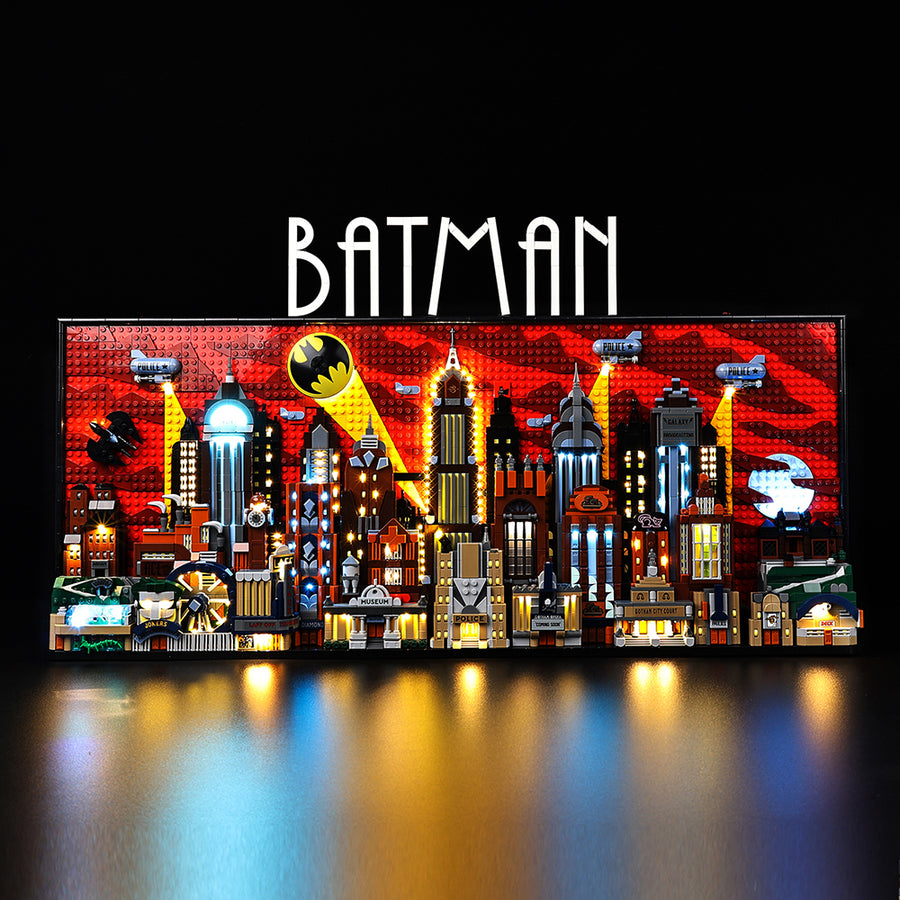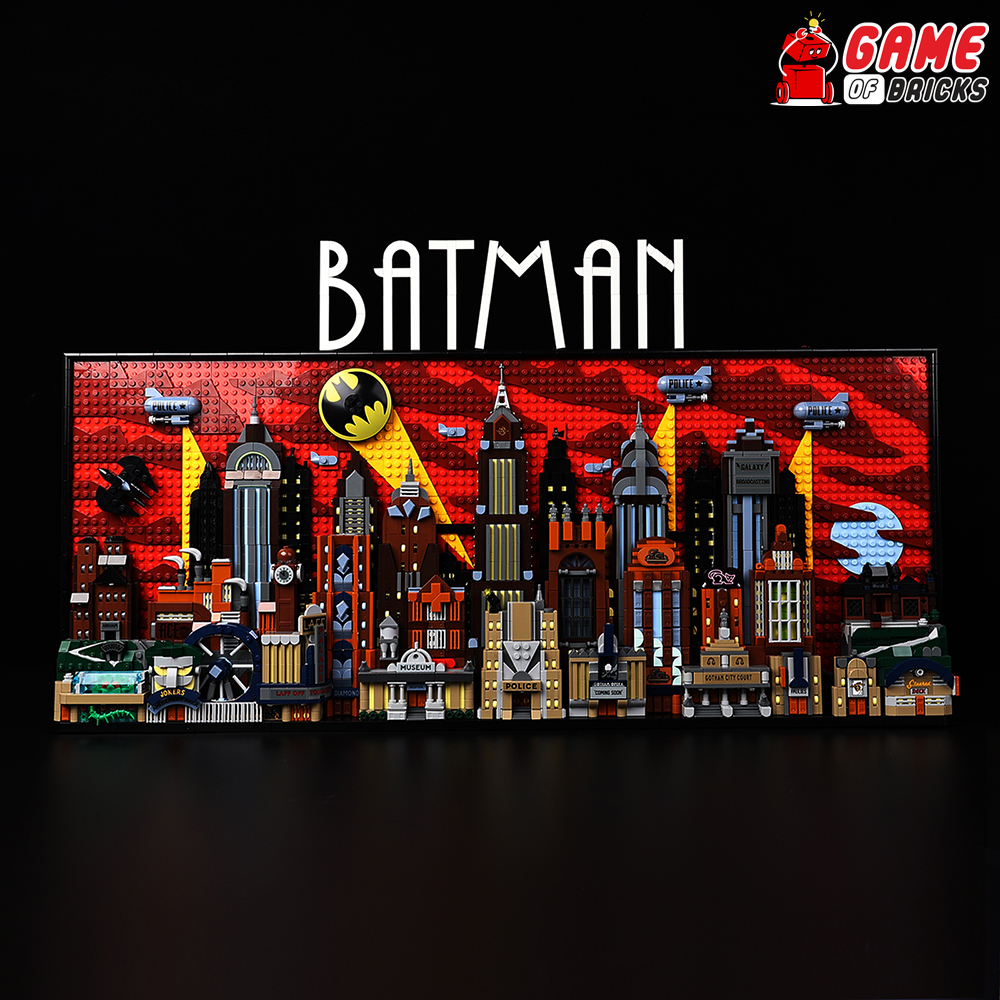The Role of Battery vs. USB Powered Lights for LEGO®
Introduction
Lighting can transform a simple LEGO® build into an eye-catching masterpiece, but the key to unlocking this magic lies in choosing the right power source. Just as a skilled painter selects their palette, a LEGO® enthusiast must decide how to power the lights that will illuminate their creation. In the realm of LEGO® lighting, two popular choices stand out: battery-powered and USB-powered solutions.
Battery power, often encapsulated in the "LEGO® light brick battery" concept, offers the allure of portability and ease, allowing builders to light up their models without the tether of cords. On the other hand, USB-powered lights provide a constant, reliable energy source, ideal for long-term displays or intricate lighting setups. Each option brings its unique set of advantages and considerations, shaping the way LEGO® enthusiasts bring their imaginative worlds to life.
This article delves into the roles and nuances of battery versus USB-powered LEGO® lights. We'll explore the benefits and limitations of each, helping you make an informed decision on which power source best suits your LEGO® project's needs. Whether you're creating a dynamic cityscape, a cozy LEGO® home, or an intricate spaceship, understanding these power options is crucial in bringing your illuminated LEGO® visions to fruition.
Battery-Powered LEGO® Lights
Advantages of Battery Power
Battery-powered lights have become a popular choice for LEGO® enthusiasts, and for good reason. Their advantages make them particularly appealing for various LEGO® projects:
- Portability: One of the most significant benefits of battery power is the ability to place your LEGO® sets anywhere, without the need for a nearby power outlet. This freedom allows for greater flexibility in display and play.
- Ease of Installation: Battery-powered lights are typically easier to install compared to wired systems. Without the need to manage cords or find power sources, builders can focus on creativity and design.
- Safety: Batteries are a safe power source, especially for younger LEGO® enthusiasts. There’s no risk of electric shock, and they can be easily handled by builders of all ages.
-
Variety of Options: The market offers a range of battery-powered lighting options, from simple single LEDs to more complex systems, catering to different project needs and skill levels.

Considerations and Limitations
While battery-powered lights offer significant advantages, there are also important considerations and limitations to keep in mind:
- Battery Life: One of the main limitations is the finite life of batteries. Depending on the battery type and light usage, they may need frequent replacements, which can be inconvenient and potentially costly over time.
- Power Intensity: Battery-powered lights may not provide the same level of brightness as their USB counterparts, especially as the battery starts to deplete.
- Environmental Impact: The use of disposable batteries raises environmental concerns. Rechargeable batteries can be an alternative, but they still require proper disposal at the end of their lifespan.
- Maintenance: Regularly checking and replacing batteries can be seen as a maintenance hassle, especially in intricate builds where the battery pack is not easily accessible.
Understanding these advantages and limitations is crucial when deciding whether battery-powered lights are the right choice for your LEGO® project. They offer a blend of ease and flexibility, making them a great starting point for those new to LEGO® lighting, but also come with considerations that need thoughtful planning.
USB-Powered LEGO® Lights
Benefits of USB Power
USB-powered lights are another popular choice for lighting LEGO® sets, offering distinct advantages that make them suitable for various applications:
- Consistent Power Supply: USB lights draw power from a USB port, ensuring a consistent and steady light output. This is particularly beneficial for long-term displays where a constant level of brightness is desired.
- Environmental Considerations: USB-powered lights are a more environmentally friendly option as they eliminate the need for disposable batteries. They can be powered through computers, USB adapters, or even power banks, offering versatility in power sources.
- Higher Brightness Levels: Generally, USB-powered lights can provide higher levels of brightness compared to battery-powered options, making them ideal for larger or more intricate LEGO® displays.
-
Cost-Effectiveness in the Long Run: While the initial setup might be more expensive, USB lighting can be more cost-effective over time, as there is no need for regular battery replacements.

Practical Aspects and Challenges
Despite their benefits, USB-powered lights also come with their own set of practical considerations and challenges:
- Dependency on Power Outlets: One of the main limitations is the need for proximity to a USB power source, which can limit where you can display your LEGO® set.
- Cable Management: Managing the USB cables can be challenging, especially in larger builds. It requires careful planning to ensure that cables are hidden and do not detract from the aesthetic of the LEGO® model.
- Less Portability: Unlike battery-powered options, USB-powered lights reduce the portability of your LEGO® set, as it needs to be close to a power source.
- Installation Considerations: Installing USB-powered lights may require more planning, particularly in terms of routing cables and ensuring easy access to a USB port.
USB-powered LEGO® lights offer a reliable and environmentally friendly lighting solution with higher brightness levels, making them suitable for complex and permanent LEGO® displays. However, their dependency on power outlets and the need for cable management are important factors to consider when choosing this type of lighting for your LEGO® project.
Comparing Battery and USB Power
Key Differences
When deciding between battery and USB power for LEGO® lights, understanding their key differences is crucial. These differences impact convenience, performance, and suitability for various LEGO® projects.
- Convenience:
- Battery Power: Offers high convenience due to its portability. Ideal for projects that are frequently moved or displayed in areas without easy access to power outlets.
- USB Power: Less convenient in terms of portability but offers the ease of not having to replace batteries. Best for stationary builds or where a power source is readily available.
- Performance:
- Battery Power: Tends to have a lower brightness level and can diminish over time as batteries wear out.
- USB Power: Provides a consistent and often brighter light output, making it suitable for intricate or larger displays that require more illumination.
- Suitability:
- Battery Power: Perfect for smaller, portable projects or where a subtle lighting effect is desired.
-
USB Power: Better suited for permanent or semi-permanent displays, large projects, or when continuous, high-intensity lighting is required.

Choosing the Right Power Source
Selecting the right power source for your LEGO® lighting project depends on several factors:
- Nature of the Project:
- Consider the size, complexity, and display location of your LEGO® build. Portable or smaller projects may benefit more from battery power, while larger, more intricate displays may require the consistent power of USB.
- Accessibility:
- Assess the ease of accessing a power outlet for USB lighting. If displaying in a location without power access, battery power is the logical choice.
- Frequency of Use:
- For LEGO® sets that are lit occasionally, battery power might be sufficient. For continuous or long-term displays, USB power is more practical.
- Environmental and Cost Considerations:
- Factor in the environmental impact and the ongoing cost of battery replacements. If these are concerns, USB-powered lighting is a more sustainable and cost-effective option.
- Personal Preference:
- Ultimately, personal preference plays a significant role. Some builders might prefer the simplicity and challenge of battery power, while others might opt for the reliability and brightness of USB-powered lights.
In summary, the choice between battery and USB power for LEGO® lights hinges on the specific needs of your project, the intended display setup, and personal preferences regarding convenience, performance, and sustainability.
Innovative Uses of LEGO® Light Bricks
Creative Applications
The versatility of LEGO® light bricks, whether battery or USB-powered, opens up a world of creative applications. Here are some innovative ways to integrate these lighting options into your LEGO® builds:
- Themed Displays: Use different lighting types to create themed displays. For instance, battery-powered lights can illuminate a mobile LEGO® carnival, while USB-powered lights can be used for a stationary cityscape that requires more consistent lighting.
- Interactive Models: Create interactive models using both types of lights. Battery-powered lights can be used for elements that need to be moved or handled, like vehicles or spacecraft, while USB lights can illuminate static parts like bases or backgrounds.
- Mixed Media Projects: Combine LEGO® with other materials like paper or fabric to diffuse light in creative ways. Battery-powered lights offer flexibility in such mixed-media projects where electrical outlets may not be accessible.
- Seasonal Decorations: Enhance seasonal LEGO® decorations, such as Christmas or Halloween scenes, using a combination of both lighting types for dynamic effects. -> Add a unique glow to your holiday decorations with a LEGO® Christmas that shines with festive charm.

Enhancing LEGO® Models
Different lighting options can significantly enhance various LEGO® models, adding depth and bringing them to life:
- Architectural Models: Illuminate LEGO® buildings with USB-powered lights for a realistic look. Use battery-powered lights for features like cars or streetlamps that add life to the scene.
- Space and Sci-Fi Themes: Create dramatic space scenes with pulsing, battery-powered lights in spacecraft, complemented by USB-powered stars and galaxies in the background.
- Fantasy Worlds: Battery-powered lights can be used to create magical effects in fantasy settings, like glowing fairies or enchanted objects, while USB lights provide a steady glow to castles or mystical landscapes.
- Action Scenes: For dynamic action scenes, use a mix of both lighting types to highlight movement and add excitement. Battery-powered lights can simulate explosions or gunfire, while USB lights provide consistent illumination for the overall scene.
By experimenting with both battery and USB-powered LEGO® light bricks, builders can explore a multitude of creative and innovative ways to enhance their LEGO® models. Each lighting type offers unique opportunities to bring imagination to light and transform ordinary builds into extraordinary displays.
Conclusion

In the world of LEGO® building, the choice between battery and USB-powered lights plays a pivotal role in bringing your creative visions to life. We’ve explored the distinct advantages and practicalities of each power source, from the portability and simplicity of battery-powered lights to the consistent and bright illumination offered by USB-powered options. Each type has its unique place in the LEGO® universe, catering to different needs, scenarios, and artistic expressions.
As you embark on your next LEGO® project, consider the role lighting plays in your creation. Whether it’s the mobility of battery power or the steady glow of USB, the right lighting can transform your build from a static model into a dynamic and engaging piece of art. We encourage you to experiment with both battery and USB-powered lights, exploring their capabilities and discovering the combination that best brings your LEGO® creations to life. Your imaginative builds, illuminated in just the right way, can offer a new perspective and a deeper appreciation for the art of LEGO® building.
We invite you to light up the LEGO® community with your experiences! Share your creations featuring either battery or USB-powered LEGO® lights and inspire fellow builders. Dive deeper into the realm of "LEGO® light brick battery" solutions and USB lighting options. Discover, experiment, and share your journey. Whether it’s a glowing cityscape or a twinkling fantasy world, your illuminated LEGO® projects have the power to spark creativity and innovation in others. Join online forums, social media groups, or local LEGO® clubs to showcase your work and explore the diverse world of LEGO® lighting.
Closing
Final Thoughts: The right lighting can truly transform a LEGO® build, turning bricks and figures into a scene brimming with life and story. Whether you choose the flexibility of battery power or the consistency of USB, the possibilities are endless. Embark on this illuminating journey and watch as your LEGO® creations shine with character and brilliance.
Top












Leave a comment